Sunday, 17 July 2016, Horses, museums, but no cablecar
Written 22 August 2016
On Sunday, our first decision of the day was not to try to drive to the evening's restaurant. It's located farther up the mountains from Megève, along a complicated route. David did not look forward to extracting the car from the parking garage, driving up there, and then hoping we could find a space in the garage (and avoid scraping the car again) when we came back down, and I didn't look forward to driving that complicated routeback the other way, in the dark. So we asked the front desk to arrange a taxi for us and to explain how we and the taxi would rendezvous, as we were on a pedestrian street.
Not a problem, we were assured. They could easily arrange a taxi, and taxis had special codes that opened the gates so that they could come right to the door to pick us up. A few minutes later, the receptionist gave us the name of the taxi, which she said had quoted a price of 30 euros, round trip.
I had hoped to ride a cable car up the mountain. The lower end of one line, the Chamois, was just a couple of blocks from the hotel. Unfortunately, the receptionist said that it didn't run in the summer, although some of the others did. They were a good deal farther away, so we decided to skip it. If you Google-map Megève, though, you'll see that its surrounded by a tangle of thin blue wavy lines (ski runs) and straight red line segments (cable-car lines). You can travel for miles from peak to peak riding them, to ski in winter or to hike in summer. Although the idea of hiking only downhill, after riding up to the top, sounds nice—my lungs and femoral triceps would thanks me—but if I hiked only downhill for three days in a row, my kneecaps would swell up and fall off.
So we went off to watch more stadium jumping.
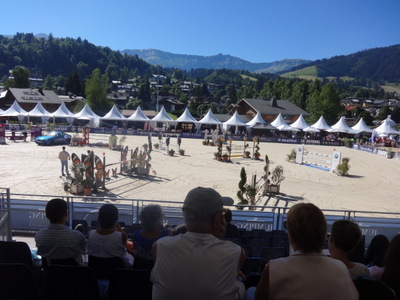
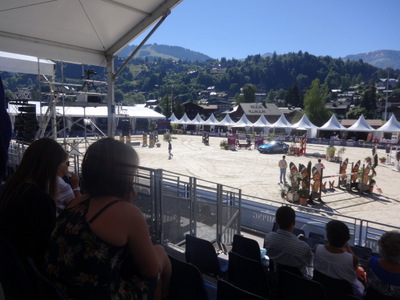 Here are a couple more views of the arena, from our seats. At the left, you can see that the jumps have been rearranged and several of them simplified. An official is bent double, near the left-most jump, carefully measuring the height of the bars. He measured every bar of every jump in turn.
Here are a couple more views of the arena, from our seats. At the left, you can see that the jumps have been rearranged and several of them simplified. An official is bent double, near the left-most jump, carefully measuring the height of the bars. He measured every bar of every jump in turn.
Leaning against the butterfly jump is a little red wheel with a tall handle attached that he then used to measure the distance from each jump to the next. This ritual was repeated before every trial, just before the riders are admitted for the walk-through.
The peaked tents along the far rail are vendor booths, selling clothing, tack, food, and wine (this is France, after all). The white-roofed structure to their left is the restaurant tent. On the hills behind, you can see the green bands of ski runs. Not visible in the photos, but discernable with binoculars, are the cables of lifts and cablecars strung from peak to peak.
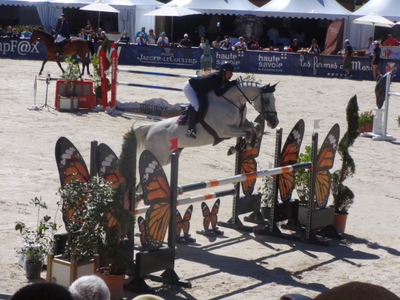
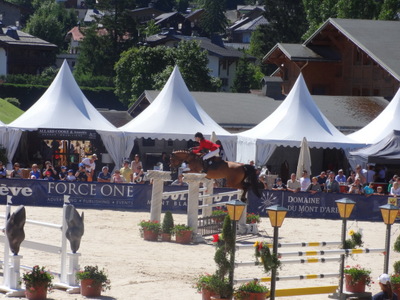 Here, in the left-hand photo, you can see how much easier the butterfly jump was made for this trial—only two bars rather than four, and the highest one has been lowered three notches.
Here, in the left-hand photo, you can see how much easier the butterfly jump was made for this trial—only two bars rather than four, and the highest one has been lowered three notches.
Before the trial began, the officials thought better of the placement of the blue mercedes you can see in the first two photos. They tried a couple of other spots but eventually moved it to a far corner of the arena, completely out of the way.
The previous day, between lack of context and the garbling effect of the PA system, I hadn't been able to make a lot of sense of the announcer's words during the awards ceremony. I caught a word I took to be "jolie" (pretty) several times, and she was blushing the whole time, so it seemed to make sense, but on the second day, I think I spotted her again—hard to say, as several of the horses were dapple gray, and all the riders were dressed alike and wore helmets—and the scoreboard displayed a name: Inez Joly. Many businesses in town had "Joly" in the name, so I think my conclusion that she was a local girl was correct.
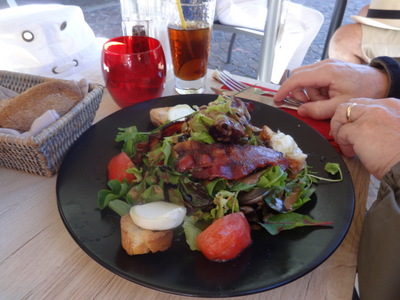
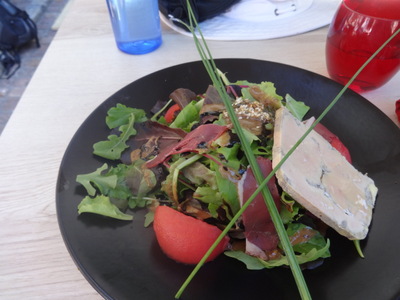 When the morning's trial was over (again, we didn't stay for the awards), we headed out in search of lunch before visiting the town's two museums both of which were only open in the afternoon.
When the morning's trial was over (again, we didn't stay for the awards), we headed out in search of lunch before visiting the town's two museums both of which were only open in the afternoon.
We found a nice assortment of salads at a place called Le Pireuré, the priory, which was appropriately enough just behind the church. As usual, David went for the hot goat cheese salad (left-hand photo), this time with bacon and boiled egg, and I chose the "salade gourmande," with slices of duck-breast ham, a slab of foie gras, and crossed chives.
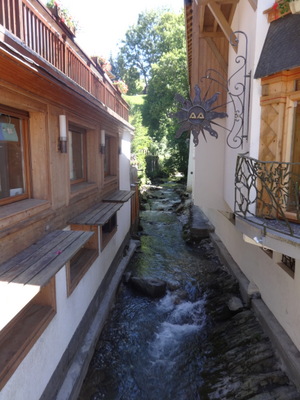
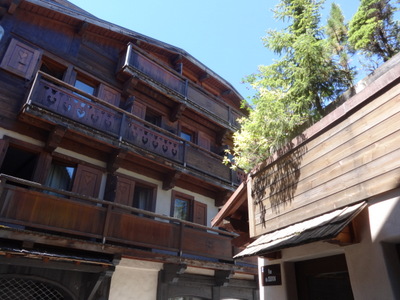 Our route there from the equestrian arena led us by our hotel, where I got this shot of the stream, as it ran below the hotel's windows (on the left).
Our route there from the equestrian arena led us by our hotel, where I got this shot of the stream, as it ran below the hotel's windows (on the left).
In the right-hand photo, my balcony is the topmost one, and at the right, you can see a corner of the wooded roof garden I overlooked.
We stopped in at the hotel to wash up and were amused to find that a new notice had appeared in the elevator, asking "our dear equestrian clients" please to remove their boots before entering their carpeted rooms.
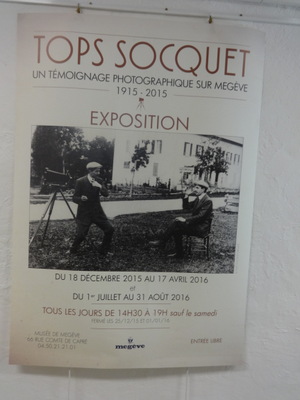
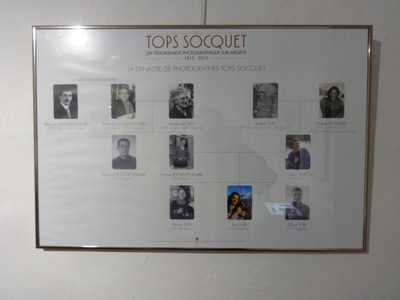 The town has two museums, both right in the middle of things, a couple of minutes apart. The first we visited was the Museum of Megève, located behind the Office de Tourisme in the old 18th century "House of Charity" building. Admission was free.
The town has two museums, both right in the middle of things, a couple of minutes apart. The first we visited was the Museum of Megève, located behind the Office de Tourisme in the old 18th century "House of Charity" building. Admission was free.
The stone building was unheated, so we wore our coats the whole time. The principal exhibition while we were there was a fascinating history and documentation of a single family, named "Tops-Socquet."
The photo at the shows the poster for the exhibition. Two brothers, Edmond and Armand Socquet-Juglard, born at the turn of the century in Paris of parents from Haute-Savoie, were sent to Megève to be raised by an aunt because they were sickly, and mountain (i.e., clean) air would be good for them. There, they got interested, not to say obsessed, with photography and started documenting life around them.
They and their descendents (diagrammed in the photo at right) spanned the entire rise and fall of amateur film photography in Megève, and the exhibit both traced that history and featured the family's huge archive of photos of life in the region.
One of the brothers opened a photographic portrait studio. Then as skiing tourists discovered amateur photography (and especially once the Rothschilds started attracting especially affluent skiing tourists), they started a business selling cameras and selling and processing film. Eventually, Armand's daughter Yvonne married Pierre Tops, son of an equally photographic family or Dutch origin, and their three kids also went into the family business.
The camera and film store prospered for decades, but then digital photography showed up. The business was gradually downsized and eventually—in 2015<—closed. Meanwhile, the three kids grew up and have branched out into other fascinating careers, all creative and often featuring photography. Yvonne and all three kids were interviewed for an excellent film that was showing continually as part of the exhibit.
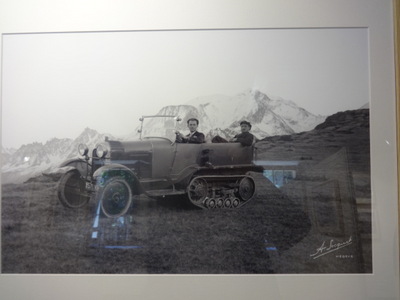
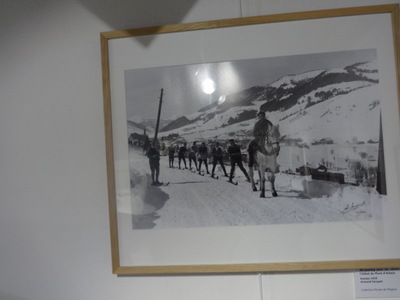 Here are just a couple of the wonderful historical photos that were part of the exhibition. The one at the left shows a half-track vehicle from the 1920s. In French, it's called a "chenillette," i.e. a caterpillarlet.
Here are just a couple of the wonderful historical photos that were part of the exhibition. The one at the left shows a half-track vehicle from the 1920s. In French, it's called a "chenillette," i.e. a caterpillarlet.
The one at the right shows a premotorized ski-lift. A horse and rider are pulling a rope to which half a dozen skiers who are clinging, to be pulled up the slope. I think rope-tows still exist, but they're probably not horse-drawn these days.
The only part of the original House of Charity that has been preserved is its baroque chapel, now open as one of the museum's exhibits.
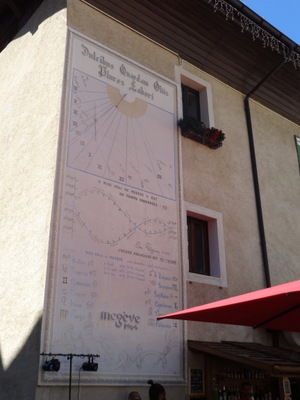
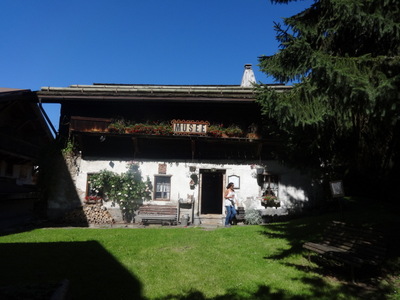 On our way up the hill to the second museum, we passed the sundial again, and I got a better photo of it. It's dated 1964. The top panel is the sundial itself. The Latin above it, "Plures labori dulcibus quaedam otiis," translates "Many [hours] for work but some for sweet idleness."
On our way up the hill to the second museum, we passed the sundial again, and I got a better photo of it. It's dated 1964. The top panel is the sundial itself. The Latin above it, "Plures labori dulcibus quaedam otiis," translates "Many [hours] for work but some for sweet idleness."
The panel below explains how to correct for time of year and, daylight savings time, etc., and the bottom panel lists of the signs of the zodiac.
The photo at the right is of the Musée du Haut Val d'Arly (the Museum of the Upper Arly Valley). It's housed in a traditional 19th century farmhouse, equally stone-walled, equally cold inside, and equally free. When we arrived, the docent on duty (standing beside the doorin the photo) was sitting on the doorstep hand-painting new row labels for the museum's demonstration garden.
This museum documents skills and traditions of life in the region around Megève, and it does an amazing job. Inside, in a warren of rooms with their original (and sometimes rather rickety) wooden floors is crammed with 19th century technology, much better labeled than is usually the case, 98% of which is made of wood.
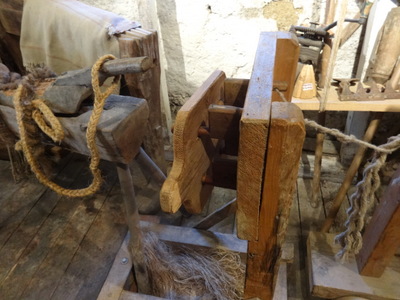
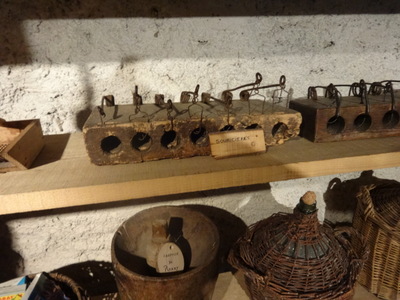 I was fascinated, not just with the kitchen area but with the bedroom, the barn, and the workshop. The photo at the left shows a hand-cranked rope-making machine, which I could figure out the workings of only because I had recently seen demonstrations of a metal one. This one works the same way, but is entirely wooden. Michael Budman, check it out!
I was fascinated, not just with the kitchen area but with the bedroom, the barn, and the workshop. The photo at the left shows a hand-cranked rope-making machine, which I could figure out the workings of only because I had recently seen demonstrations of a metal one. This one works the same way, but is entirely wooden. Michael Budman, check it out!
The device at the right is a hand-carved mouse trap! As you can see, it was one of the few devices that included metal parts. I don't know whether it was actually expected to catch seven mice at a time—I would expect the presence of one dead or struggling mouse to deter the approach of others—or whether having seven holes was just intended to increase the chance of catching one.
One display detailed the process of making wooden shoes. Another traced the history of ski and snowshoe technology. A panel explained how to make and use a fir-twig barometer. A frequent item was "combs," devices used to collect berries and arnica flowers, similar to the the comb scoops once used to harvest cranberries. Some had short handles, like dust pans with teeth along the leading edge. Others had long handles, designed to be swung along the ground by a standing person.
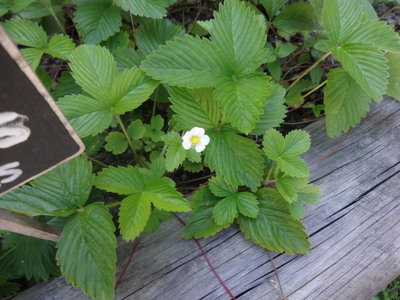
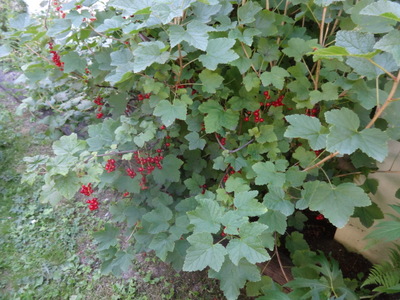 A careful examination of everything displayed would have taken a couple of days. From the displays you could form a very rich idea of what life was really like around here a hundred years ago.
A careful examination of everything displayed would have taken a couple of days. From the displays you could form a very rich idea of what life was really like around here a hundred years ago.
The demonstration garden included strawberries. The plants bore ripe berries as well as flowers like the one shown here.
The red currants were also ripe. The garden also included lots of culinary herbs and edible greens.
I would highly recommend both museums.
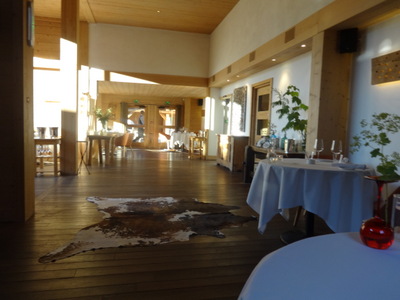
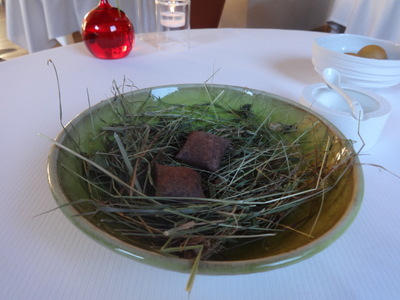 Our restaurant for the evening was Flocons de Sel, big brother to Saturday night's. As promised, the taxi arrived right at the door of the hotel, but it turned out to be not your average yellow but a big black van fitted out like a limo and driven by a guy in a sharp three-piece suit.
Our restaurant for the evening was Flocons de Sel, big brother to Saturday night's. As promised, the taxi arrived right at the door of the hotel, but it turned out to be not your average yellow but a big black van fitted out like a limo and driven by a guy in a sharp three-piece suit.
It took a good deal of time to get out of the center of town, because the pedestrian streets were crowded with people, so the van had to progress very slowly through the mob. "Just wait," said the driver, "For the Tour de France it will be 20 times worse."
The restaurant is also a very upscale hotel. It seemed quite new; you can see the quite modern decor of the dining room in the photo at the left. Note the red bud vase on our table (right edge of the photo), which is in the shape of an inverted wine glass. Every table had one, and they were all different but all in the shapes of inverted wine glasses! The photo at the right is of the first amuse-bouche, described as alpine cheese croquettes, served on a bed of hay.
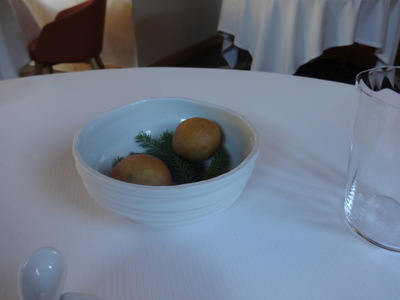
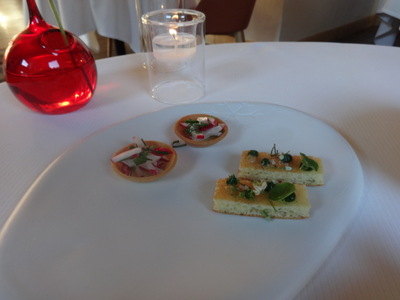 The second amuse-bouche was described as soufléed polenta bread with mountain celery. I assume the celery was in the bread, as the plant visible in the bowl was clearly fir twigs.
The second amuse-bouche was described as soufléed polenta bread with mountain celery. I assume the celery was in the bread, as the plant visible in the bowl was clearly fir twigs.
The third amuse-bouche consisted of tiny "vegan tartlets" filled with radish strips and herbs and "biscuit de Savoie" (Savoie cake) with herbs and flowers. The toppings of the latter included tiny nasturtium leaves, Chinese chive flowers, salt flakes, chopped herbs, and little dabs of a dark-green purée.
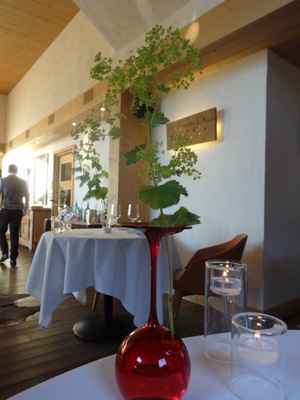
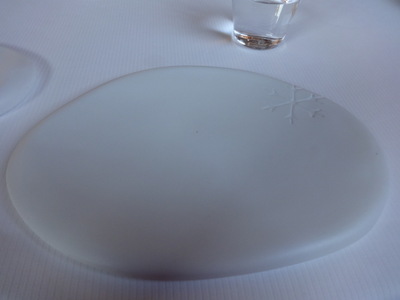 Here's a better view of the vase. The plant is inserted not through the top but through a round hole in the bowl of the "glass."
Here's a better view of the vase. The plant is inserted not through the top but through a round hole in the bowl of the "glass."
The service plate, shown at the right, is ceramic but looks like a puddle of snow with the restaurant's snowflake logo embossed into it. Some things were served on plates of the same design but different sizes.
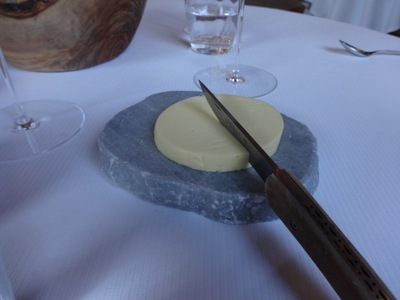
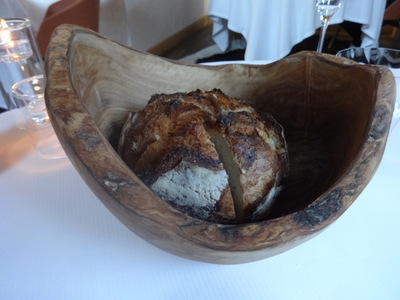 The butter was served, as has become fashionable, on a rock, and the rustic loaf of bread in a handmade wooden bowl.
The butter was served, as has become fashionable, on a rock, and the rustic loaf of bread in a handmade wooden bowl.
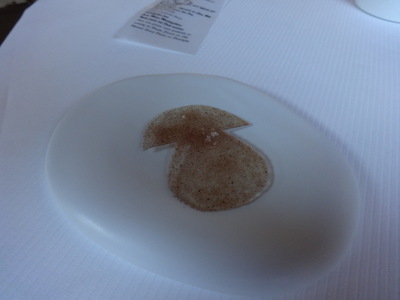
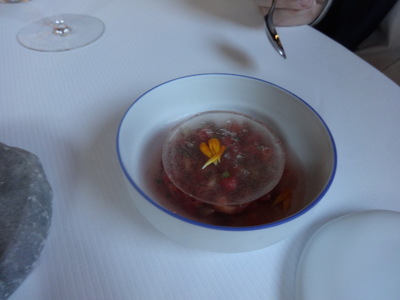 The first course was "mushroom crystals." They were served standing edgewise in slots in a small rock, but I took this one out and laid it on my bread plate so that you could see the shape into which it has been cut. It is in fact a thin sheet of mushroom-flavored rock candy, lightly sprinkled with flakes of salt. Good but odd.
The first course was "mushroom crystals." They were served standing edgewise in slots in a small rock, but I took this one out and laid it on my bread plate so that you could see the shape into which it has been cut. It is in fact a thin sheet of mushroom-flavored rock candy, lightly sprinkled with flakes of salt. Good but odd.
The second course was a mixture of chopped tomatoes of three heirloom varieties (coeur de boeuf, noire de Crimée, and rose de Berne) and garden herbs, topped with a thin round sheet of frozen tomato water and a few marigold petals. Delicious!
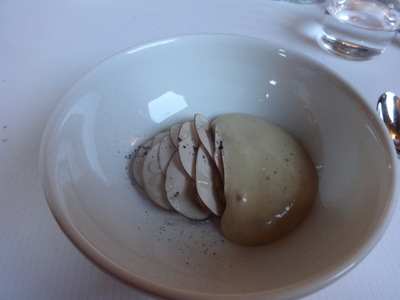
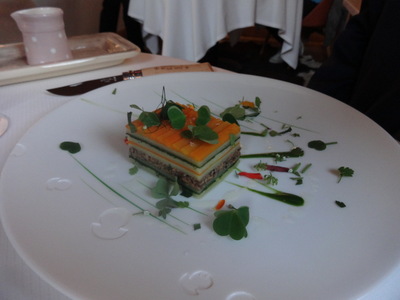 Third was was described as smoked yolk of hen's egg with coffee, raw mushrooms, and summer-savory vinaigrette. The coffee and yolk had been beaten into a sort of mousse and served with thinly sliced raw mushrooms.
Third was was described as smoked yolk of hen's egg with coffee, raw mushrooms, and summer-savory vinaigrette. The coffee and yolk had been beaten into a sort of mousse and served with thinly sliced raw mushrooms.
Because David mentioned coffee in the list of things he couldn't eat, they brought him this striped object instead. It seemed to be a sort of terrine made of layers of various vegetables (a quinoa mixture near the bottom, overlapped carrot slices on top, etc.). Note that this chef probably uses more wild plants and herbs than the guy in Grenoble but doesn't talk about it as much. This dish was sprinkled with clover and oxalis, as well as the herbs we'd already seen above. Note the little mushrooms embossed into the plate.
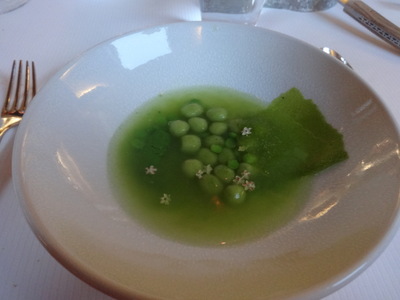
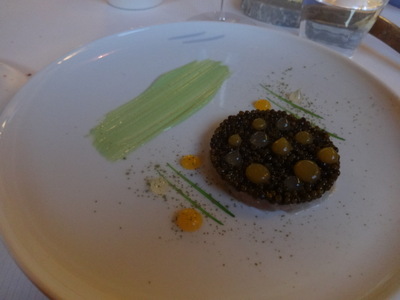 The fourth course was "flourless gnocchi" made from fresh starchy green peas, then rolled into little balls that looked like the original peas. They were served in a "garden consommé" and sprinkled with elder flowers. The green stripe is a sheet of pea mixture dried to form a sort of cookie that softened again in the broth. Very tasty.
The fourth course was "flourless gnocchi" made from fresh starchy green peas, then rolled into little balls that looked like the original peas. They were served in a "garden consommé" and sprinkled with elder flowers. The green stripe is a sheet of pea mixture dried to form a sort of cookie that softened again in the broth. Very tasty.
Fifth was a thin timbale of thinly sliced raw langoustine tails with citrus zest, topped with fromage blanc, then a layer of delicious mild caviare. The whole thing was flavored with gentian root, but because I don't know what that tastes like, I couldn't pick it out. The little multicolored splodges were purées of citrus.
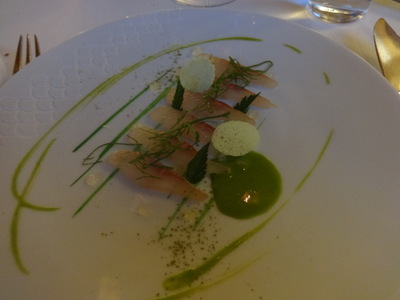
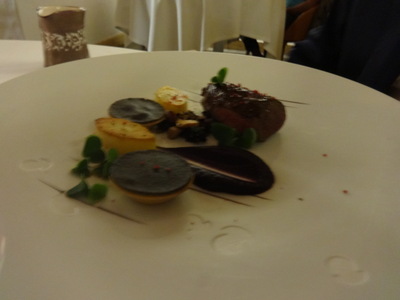 The fish course was "salt-cooked" filet of féra, served cold with sorrel and "égopode" juice. That latter is another wild mountain plant.
The fish course was "salt-cooked" filet of féra, served cold with sorrel and "égopode" juice. That latter is another wild mountain plant.
The meat course gave a choice of any meat on the à la carte menu, served in half portion. David chose venison, served rare, with a puré of blueberries and shallots. The little tartlets were also meat flavored; I think the ovals were potato.
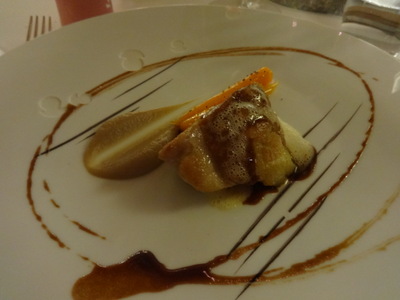
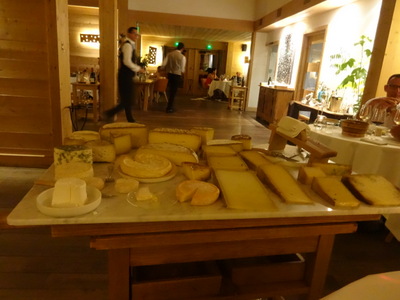
I chose sweet breads, which were excellent, also served on a mushroom plate. The foamy suace on top was a mousseline of shallots, and the amber sauce around the sides was a reduction flavored with Angostura and marjoram.
Then came the cheese trolley. No labels this time, but as usual, the waiter could recite all the names from memory.
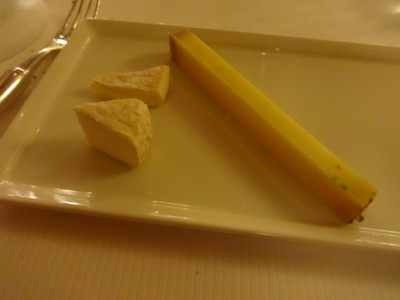
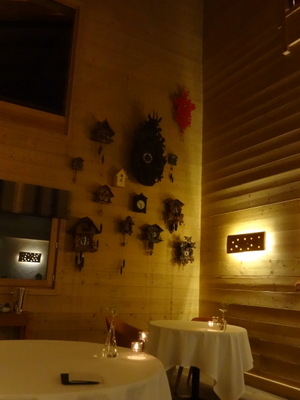 Here's my cheese plate. I choose a couple of small chevres (sorry, I didn't note which ones) and Comté. All outstanding.
Here's my cheese plate. I choose a couple of small chevres (sorry, I didn't note which ones) and Comté. All outstanding.
On a nearby wall, the restaurant displayed its collection of cuckoo clocks. Only one of them ran and kept time.
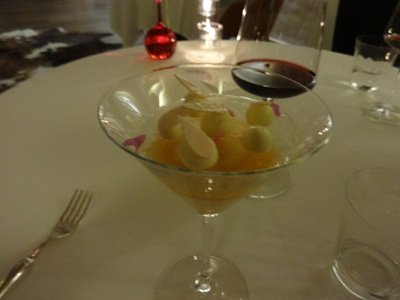
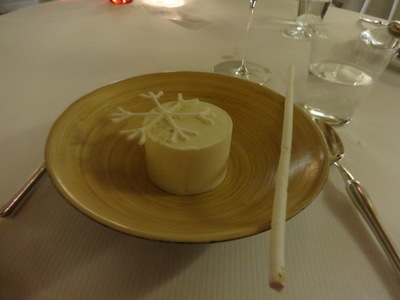 The predessert was a fruit thing served in a martini glass. Sorry I don't remember much about it, but I can assure you we didn't leave any behind.
The predessert was a fruit thing served in a martini glass. Sorry I don't remember much about it, but I can assure you we didn't leave any behind.
My dessert, chosen from a menu section called "flocons de sucre" (flakes of sugar) was ice cream made with local milk encased in a thin sheet of meringue and filled inside with a compote of rhubarb. It was decorated with more crisp meringue, in the shape of a rod and a snowflake.
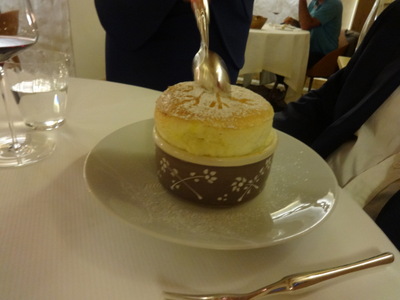
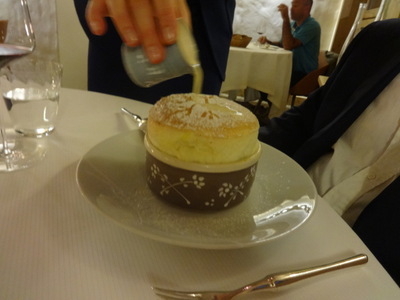 David went for the hot gentian-root soufflé, flavored with zest of citrus from Menton (we've been there; see my 2005 sabbatical diary). Note the snowflake logo stenciled on the surface in powdered sugar.
David went for the hot gentian-root soufflé, flavored with zest of citrus from Menton (we've been there; see my 2005 sabbatical diary). Note the snowflake logo stenciled on the surface in powdered sugar.
At the table, the waiter inserted a large spoon into the soufflé (left) to make an opening, then poured in gentian-flavored custard sauce. David pronounced the whole thing yummy but couldn't finish it.
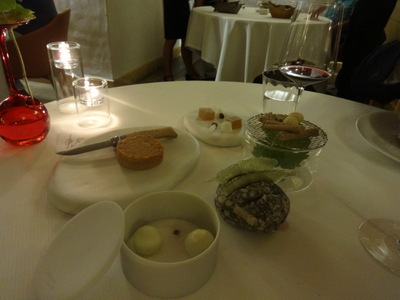
The mignardises were legion. On the white plate with the knife, a characteristic little Savoie cake; on the smaller white plate, fruit paste, chocolate-dipped meringue fingers, and a little marshmallow; on the grid-topped glass, thre kinds of candy in the shape of their flavors (cinnamon sticks, star anise pods, and almonds?); in the slots in the rock, green (herb-flavored?) sheets of sugar; in the white cylinder, on a bed of sugar, white-chocolate covered raspberry truffles. Tasty, but too much to finish.
By the time we had finished, the desk had already called our taxi, which arrived quite promptly. As we rode back down the mountain, I asked whether this road was open in winter. He assured me that it was and that he frequently drove people up and down. Plows kept the road clear during daylight hours, and the van was equipped with four-wheel drive, so he could make the round trip at night, even with a foot of snow on the ground.
The trip back through town was a little easier, since fewer people were out walking around at 11:30 p.m., but we were a little surprised to learn, when we got out, that the 30-euro price was for each way! The next morning, the receptionist seemed genuinely surprised and apologized profusely that she had misunderstood and misled us.
Previous entry
List of Entries
Next entry

 Here are a couple more views of the arena, from our seats. At the left, you can see that the jumps have been rearranged and several of them simplified. An official is bent double, near the left-most jump, carefully measuring the height of the bars. He measured every bar of every jump in turn.
Here are a couple more views of the arena, from our seats. At the left, you can see that the jumps have been rearranged and several of them simplified. An official is bent double, near the left-most jump, carefully measuring the height of the bars. He measured every bar of every jump in turn.
 Here, in the left-hand photo, you can see how much easier the butterfly jump was made for this trial—only two bars rather than four, and the highest one has been lowered three notches.
Here, in the left-hand photo, you can see how much easier the butterfly jump was made for this trial—only two bars rather than four, and the highest one has been lowered three notches.
 When the morning's trial was over (again, we didn't stay for the awards), we headed out in search of lunch before visiting the town's two museums both of which were only open in the afternoon.
When the morning's trial was over (again, we didn't stay for the awards), we headed out in search of lunch before visiting the town's two museums both of which were only open in the afternoon.
 Our route there from the equestrian arena led us by our hotel, where I got this shot of the stream, as it ran below the hotel's windows (on the left).
Our route there from the equestrian arena led us by our hotel, where I got this shot of the stream, as it ran below the hotel's windows (on the left).
 The town has two museums, both right in the middle of things, a couple of minutes apart. The first we visited was the Museum of Megève, located behind the Office de Tourisme in the old 18th century "House of Charity" building. Admission was free.
The town has two museums, both right in the middle of things, a couple of minutes apart. The first we visited was the Museum of Megève, located behind the Office de Tourisme in the old 18th century "House of Charity" building. Admission was free.
 Here are just a couple of the wonderful historical photos that were part of the exhibition. The one at the left shows a half-track vehicle from the 1920s. In French, it's called a "chenillette," i.e. a caterpillarlet.
Here are just a couple of the wonderful historical photos that were part of the exhibition. The one at the left shows a half-track vehicle from the 1920s. In French, it's called a "chenillette," i.e. a caterpillarlet.

 On our way up the hill to the second museum, we passed the sundial again, and I got a better photo of it. It's dated 1964. The top panel is the sundial itself. The Latin above it, "Plures labori dulcibus quaedam otiis," translates "Many [hours] for work but some for sweet idleness."
On our way up the hill to the second museum, we passed the sundial again, and I got a better photo of it. It's dated 1964. The top panel is the sundial itself. The Latin above it, "Plures labori dulcibus quaedam otiis," translates "Many [hours] for work but some for sweet idleness."
 I was fascinated, not just with the kitchen area but with the bedroom, the barn, and the workshop. The photo at the left shows a hand-cranked rope-making machine, which I could figure out the workings of only because I had recently seen demonstrations of a metal one. This one works the same way, but is entirely wooden. Michael Budman, check it out!
I was fascinated, not just with the kitchen area but with the bedroom, the barn, and the workshop. The photo at the left shows a hand-cranked rope-making machine, which I could figure out the workings of only because I had recently seen demonstrations of a metal one. This one works the same way, but is entirely wooden. Michael Budman, check it out!
 A careful examination of everything displayed would have taken a couple of days. From the displays you could form a very rich idea of what life was really like around here a hundred years ago.
A careful examination of everything displayed would have taken a couple of days. From the displays you could form a very rich idea of what life was really like around here a hundred years ago.
 Our restaurant for the evening was Flocons de Sel, big brother to Saturday night's. As promised, the taxi arrived right at the door of the hotel, but it turned out to be not your average yellow but a big black van fitted out like a limo and driven by a guy in a sharp three-piece suit.
Our restaurant for the evening was Flocons de Sel, big brother to Saturday night's. As promised, the taxi arrived right at the door of the hotel, but it turned out to be not your average yellow but a big black van fitted out like a limo and driven by a guy in a sharp three-piece suit.
 The second amuse-bouche was described as soufléed polenta bread with mountain celery. I assume the celery was in the bread, as the plant visible in the bowl was clearly fir twigs.
The second amuse-bouche was described as soufléed polenta bread with mountain celery. I assume the celery was in the bread, as the plant visible in the bowl was clearly fir twigs.
 Here's a better view of the vase. The plant is inserted not through the top but through a round hole in the bowl of the "glass."
Here's a better view of the vase. The plant is inserted not through the top but through a round hole in the bowl of the "glass."
 The butter was served, as has become fashionable, on a rock, and the rustic loaf of bread in a handmade wooden bowl.
The butter was served, as has become fashionable, on a rock, and the rustic loaf of bread in a handmade wooden bowl.
 The first course was "mushroom crystals." They were served standing edgewise in slots in a small rock, but I took this one out and laid it on my bread plate so that you could see the shape into which it has been cut. It is in fact a thin sheet of mushroom-flavored rock candy, lightly sprinkled with flakes of salt. Good but odd.
The first course was "mushroom crystals." They were served standing edgewise in slots in a small rock, but I took this one out and laid it on my bread plate so that you could see the shape into which it has been cut. It is in fact a thin sheet of mushroom-flavored rock candy, lightly sprinkled with flakes of salt. Good but odd.
 Third was was described as smoked yolk of hen's egg with coffee, raw mushrooms, and summer-savory vinaigrette. The coffee and yolk had been beaten into a sort of mousse and served with thinly sliced raw mushrooms.
Third was was described as smoked yolk of hen's egg with coffee, raw mushrooms, and summer-savory vinaigrette. The coffee and yolk had been beaten into a sort of mousse and served with thinly sliced raw mushrooms. 
 The fourth course was "flourless gnocchi" made from fresh starchy green peas, then rolled into little balls that looked like the original peas. They were served in a "garden consommé" and sprinkled with elder flowers. The green stripe is a sheet of pea mixture dried to form a sort of cookie that softened again in the broth. Very tasty.
The fourth course was "flourless gnocchi" made from fresh starchy green peas, then rolled into little balls that looked like the original peas. They were served in a "garden consommé" and sprinkled with elder flowers. The green stripe is a sheet of pea mixture dried to form a sort of cookie that softened again in the broth. Very tasty.
 The fish course was "salt-cooked" filet of féra, served cold with sorrel and "égopode" juice. That latter is another wild mountain plant.
The fish course was "salt-cooked" filet of féra, served cold with sorrel and "égopode" juice. That latter is another wild mountain plant.


 Here's my cheese plate. I choose a couple of small chevres (sorry, I didn't note which ones) and Comté. All outstanding.
Here's my cheese plate. I choose a couple of small chevres (sorry, I didn't note which ones) and Comté. All outstanding.
 The predessert was a fruit thing served in a martini glass. Sorry I don't remember much about it, but I can assure you we didn't leave any behind.
The predessert was a fruit thing served in a martini glass. Sorry I don't remember much about it, but I can assure you we didn't leave any behind.
 David went for the hot gentian-root soufflé, flavored with zest of citrus from Menton (we've been there; see my 2005 sabbatical diary). Note the snowflake logo stenciled on the surface in powdered sugar.
David went for the hot gentian-root soufflé, flavored with zest of citrus from Menton (we've been there; see my 2005 sabbatical diary). Note the snowflake logo stenciled on the surface in powdered sugar. 